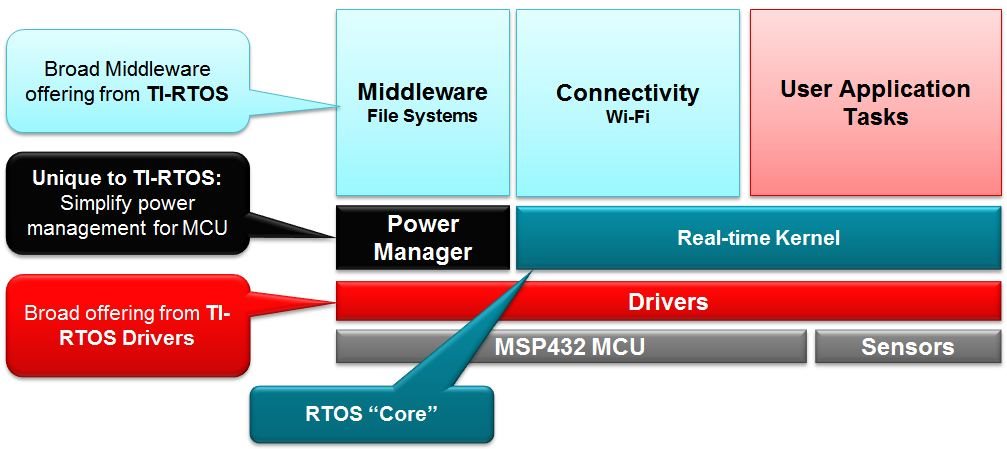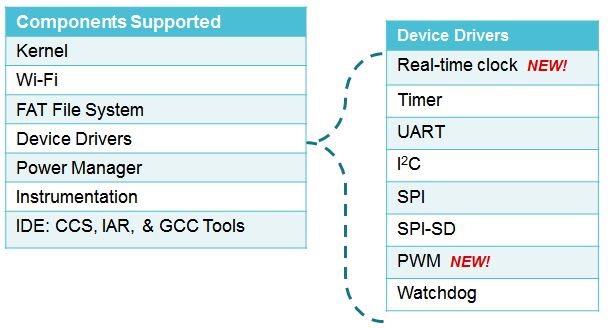SSZTCO7 may 2015 TMP006
As your product performance needs are increasing, you may consider porting your existing MSP430 MCU design to TI's new high performance MSP432 MCU platform. Alternatively, as your product power consumption needs are decreasing, you may be considering porting your existing ARM design to our new low-power MSP432 MCU platform. Developing with 32-bit ARM systems often requires juggling multiple activities at once – which is where a Real-time Operating System (RTOS) can come in handy.
MSP432 MCUs offer compatibility with several TI RTOS solutions (including TI-RTOS and Energia MT) and third-party RTOS solutions (including FreeRTOS, ARM CMSIS-RTX and Micrium-OS).
Using an RTOS accelerates development schedules by eliminating the need to create basic system software functions from scratch and makes the task of managing several resources in more complex embedded systems… well, manageable!
For the bare-bone option using only the kernel, starting with just 4kB of code, you can already gain access to a number of great features such as multi-tasks, software interrupts, software timers, or even tickless operation optimized for low-power modes. For those of you who want a little more muscle in the RTOS, TI-RTOS (and potentially ARM RTX) also comes with a number of robust drivers that help you efficiently control various peripherals or communication layers such as Wi-Fi, TCP-IP, or serial communication in no time. Some of these RTOSes are also specifically written to leverage the ultra-low-power features crafted into each MSP432 MCU. For example, TI-RTOS has a unique power management module that can configure the entire system based on your performance needs, abstracting away lines and lines of code with a single simple API.
By providing essential system software components pre-tested and pre-integrated, an RTOS enables developers to immediately focus on differentiating their application.
In this upcoming RTOS blog series, we’ll highlight different RTOS solutions available to use with the new MSP432 MCUs. Today we’ll start with TI-RTOS. And next in this series, we’ll discuss:
- - Using FreeRTOS from Real-Time Engineers Ltd with MSP432 MCUs (June 1)
- - Using ARM CMSIS-RTX from Keil with MSP432 MCUs (June 9)
TI-RTOS is developed and maintained by TI, and is fully supported on MSP432 MCUs with over 50 examples! Here you’ll see the key structure of TI-RTOS:

For added power savings, use Power Manager to simplify and optimize power during run time. This is a unique feature to TI-RTOS not found in other RTOS solutions.
To ease software development, TI-RTOS also includes power-aware drivers that work with the TI-RTOS Kernel, or can even be used with other RTOS solutions. Here you’ll see a list of the drivers that TI-RTOS supports.

And, for those Energia fans – TI-RTOS provides the underlying structure for Energia MT, which is the first hobbyist-oriented multi-thread IDE supporting MSP432 MCUs!
To test out TI-RTOS with MSP432 MCUs for yourself, take a look at the BoosterPacks supported with TI-RTOS that you can connect to your MSP432 LaunchPad:
- CC3100BOOST SimpleLink Wi-Fi Booster Pack
- SD-Card BoosterPack
- 430BOOST-TMP006 TMP006 BoosterPack
- 430BOOST-SHARP96 Sharp Memory LCD BoosterPack
- DLP-RF430BP RF430CL330 NFC Transponder
- TPL0401EVM Board
To go more in depth on TI-RTOS with MSP432 – check out these new trainings and resources: